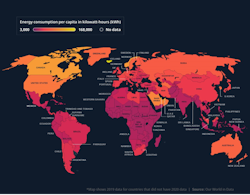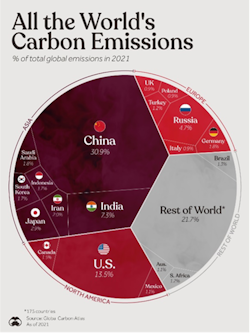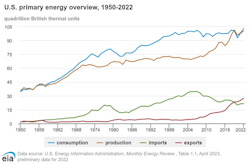USA: a race towards energy independence

Energy Observer is experiencing her last international stopovers before going back to her home port: after calling at Miami and having just arrived in Washington, she will soon set sail for New York, and Boston. The occasion for us to look with curiosity at the profound transformation United States’ energy landscape is undergoing. For decades, the nation's energy mix has been dominated by fossil fuels, but the momentum is shifting decisively towards renewable sources and energy efficiency technologies. This transition presents both significant challenges and unprecedented opportunities as the U.S. strives to achieve a more sustainable, reliable, and equitable energy future. Explications with our onboard scientist and energy expert, Beatrice Cordiano.
First thing that pops up in our minds when we think about the United States is a capitalist economy and a consumer culture. Americans consume goods: food, cars and…energy. A lot of energy. In fact, Americans constitute 4% of the world’s population and consume 15% of the world’s primary energy. To put it in perspective, an American consumes as much energy as 2 French, 4 Mexicans, and 90 Ethiopians. Overall, the North American country is the second largest energy consumer worldwide.

Power generation, industries, transport, and many other sectors make the United States responsible for pumping billions of tonnes of global-warming gases into the atmosphere every year. Having been outpaced by China in the mid-2000s, the U.S. is the second biggest emitter of greenhouse gases - with about 6 billion tons of CO2 equivalent emitted in 2022 - and has produced more cumulative emissions of carbon dioxide than any other country to date. For this, the United States is regarded as the biggest contributor to man-made climate change.

Not a very bright picture, which makes us wonder: how does the U.S. address its huge energy needs, how - if at all - has its approach shifted in time and what does that mean for meeting the country’s emission reduction targets? As you might guess, the answer is pretty complex.
Prior to the 1950s, the U.S generated most of the energy it consumed. However, from 1957 until 2018 consumption consistently exceeded production and a reliance on imports, primarily crude oil and refined fuels, was key to bridge the gap. This import dependence peaked in 2007 and since then it has constantly declined thanks to the rise in the domestic production of petroleum and natural gas, which allowed to lessen import needs and even facilitated exports.

In 2019, for the first time in almost 70 years, the US became a net energy exporter. This means it sold more oil and gas internationally than it imported. The reason primarily lies in the "shale revolution": through innovative drilling techniques like fracking (hydraulic fracturing) and horizontal drilling previously unreachable oil and gas deposits became accessible. Additionally, with the development of LNG export terminals, natural gas started to be shipped abroad just like oil.
Fact check on American energy independence
But let’s dispel a myth. Being a net energy exporter means neither zero imports nor being energy independent, as many Americans blame. First, because fossil fuels are exposed to global markets and the US, even in this goldish situation, doesn’t get to set the prices for energy.
The high volatility of fossil fuels prices hits Americans too, and especially those who do not have another alternative to gasoline to power their car or gas to heat their homes. Second, because crude oil must be refined to be used and, while American refineries are mainly built to process heavy crude oils, the domestically produced oil is typically “light”, reason why the country needs to import another type of oil to make end products.
Then no, the U.S. is not energy independent - in the sense that it produces more than enough for its needs - and it hasn’t been since 1953. One solution to that is electrification. But electrification means renewables.

Change is here even in the oil country
Let’s first take a step back to understand the American energy mix. Over the past 65 years, the sources of the U.S. energy consumption have mirrored trends in production. While petroleum remains the top source, its dominance has declined (43% in 1957 to 36% in 2022). Similarly, coal's share has significantly shrunk (26% to 10%). On the contrary, natural gas has risen in prominence (24% to 33%). Renewable and nuclear energy also hold larger shares today compared to 1957, yet they cover today only 21% (13% and 8% respectively) of the primary energy needs.

Nevertheless, we cannot deny a quiet but profound shift is underway across the States, mirroring a well underway transition already happening in Europe and other regions. Car manufacturers are turning electric, and this trend goes beyond transportation, encompassing areas like heating, cooling and cooking too. Renewable energy is booming in the United States and the country is catching up at a surprising pace.
“We look at energy data on a daily basis, and it’s astonishing what’s happening. […] Clean energy is moving faster than many people think, and it’s become turbocharged lately”

This is because the cost of electricity generation from solar and wind is declining rapidly and is now often cheaper than fossil fuels. Once considered expensive and impractical, solar panels, wind turbines and lithium-ion batteries as well, have transitioned from niche technologies to mainstream solutions in just 15 years.
Going back now to our initial question: how can electrification solve part of the American energy independency equation?
Using electricity is indeed more stable and cheaper than using fossil fuels, we all know that. Prices for fossil fuels are highly dependent on geopolitical and climate risks – it happened during the pandemics, we have seen it for the price of natural gas as a consequence of the Ukraine war, we are experiencing it with oil prices now that tensions are escalating in the Red Sea. Prices can rise rapidly, and they have done so several times in these last 5 years. On the contrary, electricity prices stay relatively low and less volatile. Why is that?
First, because unlike fossil fuels, which are traded globally and are therefore susceptible to international price fluctuations, electricity markets are generally local. Second, because renewables like solar and wind have become cheaper, are freely available, and the cost of their electricity is primarily determined by the upfront construction cost.
So, even though the grid still relies partially on fossil fuels, electricity has the power to reduce dependence on a volatile market and offers protection from price shocks.
The power of legislation
The United States has long been a magnet for renewable energy investments due to its existing market potential and this appeal was significantly boosted in August 2022 with the Inflation Reduction Act (IRA) passed by the Biden administration, a legislation expected to accelerate the pace of the nation's energy transition focusing on two complementary solutions : a renewable electrification and the establishment of a robust clean hydrogen value chain.
However, a Republican victory in the 2024 presidential election would likely reverse efforts to reduce emissions. A worrying scenario that would ramp up fossil fuel production, rolling back regulations aimed at curbing greenhouse gases and dismantling nearly all federal clean energy programs.
Transforming the US power systems is a monumental task. Significant renewable energy capacity needs to be added into an aging and inefficient grid: a huge challenge without adding energy storage and removing, re-engineering, and replacing the current infrastructure. Besides, despite the success of these clean sources of energy, corporations are still investing in new coal mines, gas pipelines and oil rigs, and the government doesn’t seem to stop granting leases for drilling projects and subsidies for these industries. And while energy systems are evolving rapidly, so is the climate.
What’s next no one knows until November 5th. But what is certain is that by now, achieving net-zero emissions by 2050 - as scientists urge to avoid climate catastrophe - remains an uncertain goal for United States, and that if America wants to reach energy independency it cannot do it remaining the petroleum-based energy economy it was in the mid-50s.